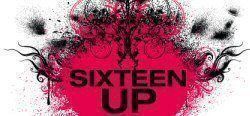Every new generation faces much the same obstacles as the last. The challenge when making theatre about growing up is to cover the same old problems in new and relevant ways.
So it's only a mild criticism to say that Box Clever's Sixteen Up offers few truly original insights. We already know falling in love for the first time is exhilarating, awkward and often painful, or that it's difficult to talk to your parents about sex. It's the presentation of these ideas that matters.
Box Clever's presentation consists of two capable performers, two very nifty set pieces and a musician.
Two wheeled wooden structures each double as a projector screen and a nightclub podium or cosy bedroom. The projectors are built in, along with several carefully placed spotlights, so the boxes can be wheeled about without the need for refocusing.
These mobile screens are the canvas for Carl Stevenson's animated films, which clarify the setting for certain scenes, as well as showing the world through the characters' eyes.
For instance, Adam's parents are represented through giant cartoonish images: his mother's knobbly knees and impatiently tapping slipper, or his dad's enormous bloodshot eye peering through his partly-open bedroom door.
Similarly, Evie's two friends are stick figures doodled on squared paper. Their mouths appear first, and they are differentiated largely through the accents Evie (Elizabeth Cadwallader) adopts to portray them; the squared paper background gives the scene's setting, a maths lesson.
Stevenson's films also inject some colour into the otherwise blank canvas of the stage, along with Itai Erdal's soft pastel lighting,.
From the side of the stage, musician Matt Hales - best known for his work with piano balladeers Aqualung - sits with his acoustic guitar, providing punctuation, accompaniment and short incidental songs.
Lyrically the compositions are somewhat lacking, but climbing minor chords or rapidly strummed staccato notes really enhance the urgency of the emotionally-charged dialogue.
Sixteen Up is less a play about sexual awakening than it is about the impossibility of verbally communicating complex feelings experienced for the first time - whether to your parents, friends or new partner.
Michael Wicherek's monologues employ a loose verse style, with a pleasant rhythm and rhymes casually dropped in wherever the opportunity arises. But when the characters enter dialogue, the eloquence of their inner monologues dries up into meaningless niceties, illustrated on screen by mobiles texting the lines as they're spoken.
Of the two performers, Lloyd Thomas (Adam) has a better grasp of the rhythm of the lines, but Elizabeth Cadwallader demonstrates greater vocal versatility when voicing her friends or her Act Two boyfriend (a hoodie on a coathanger).
Both Thomas and Cadwallader give confident physical performances where Georgina Lamb's movement direction demand them. Most importantly, they have believable onstage chemistry.
The play has some pacing issues. Wicherek occasionally revels so much in the expressiveness of his language that he continues monologues past the point where they've said all they need to say.
But as aforementioned, the cannot avoid reiteration - and one of the play's recurring motifs is that it isn't what you say that matters, it's how you say it. Sixteen Up says it with a balanced mixture of media that is both skilful and engaging.
Until 22nd November, 2008, then at York Theatre Royal (24th-26th November, 2008), The Hawth Studio (2nd December, 2008), and Gulbenkian Theatre (4th December, 2008)
